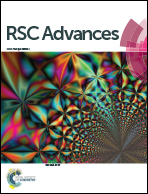Structural stability and bonding nature of Li–Sn–carbon nanocomposites as Li-ion battery anodes: first principles approach†
Abstract
The atomic structural stability and electronic properties of LinSn4–carbon nanotube (CNT) and LinSn4–graphene nanocomposites were studied by first principles calculations. Results on isolated LinSn4 clusters, with n = 0–10, revealed that the tetrahedron shaped Li4Sn4 Zintl cluster is the most stable owing to it having high symmetry as well as a largest highest occupied molecular orbital–lowest unoccupied molecular orbital (HOMO–LUMO) gap. This LinSn4 cluster weakly interacted with CNT as well as graphene for n ≤ 4, whereas a strong cation–π interaction is observed between them for n > 4 which significantly reduces the Li clustering. The interaction between the Sn cluster and CNT or graphene is mediated only through Li ions whose absence destabilizes the Sn–C composite. These results were further confirmed by electronic density of states and band structure calculations. In addition, our calculations on hexagonal assembly of LinSn4–CNT imply that the volume change is minimal during lithiation and the average intercalation potential is estimated to be a maximum of ≈0.5 V, which shows its good anodic character.


 Please wait while we load your content...
Please wait while we load your content...